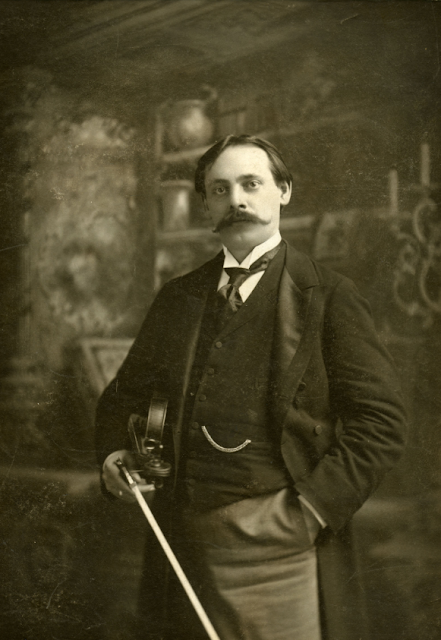Spotlight on Ernesto Vallejo - The Filipino Violin Virtuoso
Vallejo spent his elementary schooling at Santa Cruz Primary School and, from there, went to Mabini Intermediate School and later to Manila North High School. He was always presented in music programs in schools and was also featured at the Zorrilla Theater, the Army and Navy Club, and at the Columbia Club, not only on the violin but also on the guitar, an instrument he also mastered.
His talent was soon noticed by the likes of Prof. Marcelo Adonay and Prof. Bonifacio Abdon, studying the violin for years with the latter under the auspices of the Asociacion Musical de Filipinas. Fondly called "Vallejito" by his peers due to his short stature, visiting renowned artists who saw him perform would soon notice and give their accolades.
Mishel Piastro (one-time Concertmaster of the New York Philharmonic) heard him play in Manila when he was 13 and said:
"It is a crime that this child should continue here longer. Of the 11 million Filipinos, I am sure there is only one Vallejo. What is more, I doubt that in the entire Malay race, he has his equal."
Mischa Elman, renowned Jewish American violinist:
Mischa Elman, renowned Jewish American violinist:
"No time should be lost in sending young Vallejo to the United States. To fail to do so would be to lose a genius who will bring honor to the Philippines.
With the help of Filipino philanthropist and Art patron Dr. Ariston Bautista Lin, the Philippine government granted Vallejo a scholarship. On Oct 1923, at the age of fourteen, he left the country as a pensionado and remained in the US for six years.
Ernesto Vallejo studied under renowned American violinist Franz Kneisel, while also continuing his high school education at Riverside Country School, New York.
Vallejo related that when Kneisel saw him play and listen to him for the first time, he immediately took him into his class instead of assigning him to one of his assistant teachers. Vallejo then related:
 |
| Mischa Elman |
With the help of Filipino philanthropist and Art patron Dr. Ariston Bautista Lin, the Philippine government granted Vallejo a scholarship. On Oct 1923, at the age of fourteen, he left the country as a pensionado and remained in the US for six years.
Ernesto Vallejo studied under renowned American violinist Franz Kneisel, while also continuing his high school education at Riverside Country School, New York.
Vallejo related that when Kneisel saw him play and listen to him for the first time, he immediately took him into his class instead of assigning him to one of his assistant teachers. Vallejo then related:
"He told me not to be offended, but my bowing was all wrong, and that the secret of the great violinist lies in the bowing. He made me practice one bar for two weeks to two months, over and over again. Every moment in the bowing and fingering had to be perfect. I practiced seven hours a day. But everything went smoothly, and only a year afterward, I made my debut at Palm Beach."
In 1926, Franz Kneisel died. Vallejo continued his violin study under Sacha Jacobsen, a pupil of Kneisel. On March 1929, for his graduation concert, Ernesto Vallejo was presented at Town Hall, New York. He performed Edouard Lalo's Symphonie Espagnole and Brahms' Sonata in A major.
In September 1929, Vallejo returned to Manila and did a homecoming concert at the Manila Grand Opera House.
Dr. Alexander Lippay (MSO founder and director), at that time, in a description of Vallejo artistry, mentioned:
Ernesto Vallejo would then devote his career in the Philippines to performance and teaching. He is also remembered having been the maestro of some of the finest violinists and violin pedagogues in the country.
Tragic End
During the latter part of Japanese occupation, Ernesto Vallejo and his family were invited by a patron-friend from Tanauan, Batangas to evacuate to the said province.
But on February 10, 1945, in a horrendous case of Japanese brutality, just when the American liberation forces were about to enter the province of Batangas, several civilians were gunned down in the town of Tanauan, massacred by the panicking Japanese soldiers.
 |
| Franz Kneisel (1865-1926) |
In 1926, Franz Kneisel died. Vallejo continued his violin study under Sacha Jacobsen, a pupil of Kneisel. On March 1929, for his graduation concert, Ernesto Vallejo was presented at Town Hall, New York. He performed Edouard Lalo's Symphonie Espagnole and Brahms' Sonata in A major.
In September 1929, Vallejo returned to Manila and did a homecoming concert at the Manila Grand Opera House.
Dr. Alexander Lippay (MSO founder and director), at that time, in a description of Vallejo artistry, mentioned:
"He plays everything with soul and his interpretation is always intelligent. His tone and modulation are beautiful, and his bowing technique masterful. There is no question about his talent. Although only 20 years old, he plays with the maturity of a man of forty. It is phenomenal!"
 |
| Dr. Alexander Lippay |
Ernesto Vallejo would then devote his career in the Philippines to performance and teaching. He is also remembered having been the maestro of some of the finest violinists and violin pedagogues in the country.
Tragic End
During the latter part of Japanese occupation, Ernesto Vallejo and his family were invited by a patron-friend from Tanauan, Batangas to evacuate to the said province.
But on February 10, 1945, in a horrendous case of Japanese brutality, just when the American liberation forces were about to enter the province of Batangas, several civilians were gunned down in the town of Tanauan, massacred by the panicking Japanese soldiers.
Among the victims were Ernesto Vallejo and his family.
An ignominious end to one outstanding Filipino artist, who could have given the country more of his artistry, had he lived longer.

.png)


Comments
Post a Comment